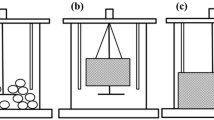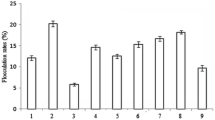Abstract
The great performance of a fibrous bed bioreactor (FBB) is mainly dependent on the cell adhesion and immobilization into the fibrous matrix. Therefore, understanding the mechanism and factors controling cell adhesion in the fibrous matrix is necessary to optimize the FBB setup and further improve the fermentability. The adhesion behavior of a strain of Clostridium tyrobutyricum isolated from an FBB was studied, which was proven to be affected by the different environmental conditions, such as growth phase of cells, pH, ionic strength, ionic species, and composition of media. Our results also suggested that electrostatic interactions played an important role on bacteria adhesion into the fibrous matrix. This study demonstrated that the compositions of fermentation broth would have a significant effect on cell adhesion. Consequently, a two-stage glucose supply control strategy was developed to improve the performance of FBB with higher viable cell density in the operation of the FBB setup.





Similar content being viewed by others
References
Yang, S.T. (1996). Extractive fermentation using convoluted fibrous bed bioreactor useful for converting sugars into organic acids and their salts, US Patent 5,563,069-A.
Suwannakham, S., & Yang, S. T. (2005). Enhanced propionic acid fermentation by Propionibacterium acidipropionici mutant obtained by adaptation in a fibrous-bed bioreactor. Biotechnology and Bioengineering, 91, 325–337.
Hayashi, H., Ono, M., Tsuneda, S., et al. (2002). Three-dimensional immobilization of bacterial cells with a fibrous network and its application in a high-rate fixed-bed nitrifying bioreactor. Journal of Chemical Engineering Japan, 35, 68–75.
Zhu, Y., & Yang, S. T. (2003). Adaptation of Clostridium tyrobutyricum for enhanced tolerance to butyric acid in a fibrous-bed bioreactor. Biotechnology Progress, 19, 365–372.
Huang, Y. L., Mann, K., Novak, J. M., et al. (1998). Acetic acid production from fructose by Clostridium formicoaceticum immobilized in a fibrous-bed bioreactor. Biotechnology Progress, 14, 800–806.
Tay, A., & Yang, S. T. (2002). Production of L(+)-lactic acid from glucose and starch by immobilized cells of Rhizopus oryzae in a rotating fibrous bed bioreactor. Biotechnology and Bioengineering, 80, 1–12.
Zhang, A., & Yang, S. T. (2009). Engineering Propionibacterium acidipropionici for enhanced propionic acid tolerance and fermentation. Biotechnology and Bioengineering, 104, 766–773.
Bai, Y. L., & Yang, S. T. (2005). Biotransformation of R-2-hydroxy-4-phenylbutyric acid by d-lactate dehydrogenase and Candida boidinii cells containing formate dehydrogenase coimmobilized in a fibrous bed bioreactor. Biotechnology and Bioengineering, 92, 137–146.
Kilonzo, P., Margaritis, A., & Bergougnou, M. (2009). Airlift-driven fibrous-bed bioreactor for continuous production of glucoamylase using immobilized recombinant yeast cells. Journal of Biotechnology, 143, 60–68.
Yang, S. T., Lo, Y. M., & Min, D. B. (1996). Xanthan gum fermentation by Xanthomonas campestris immobilized in a novel centrifugal fibrous-bed bioreactor. Biotechnology Progress, 12, 630–637.
Chen, C. N., Huang, Y. L., & Yang, S. T. (2002). A fibrous-bed bioreactor for continuous production of developmental endothelial locus-1 by osteosarcoma cells. Journal of Biotechnology, 97, 23–39.
Ouyang, A., & Yang, S. T. (2008). A two-stage perfusion fibrous bed bioreactor system for mass production of embryonic stem cells. Expert Opinion on Biological Therapy, 8, 895–909.
Yang, S. T., & Shu, C. H. (1996). Kinetics and stability of GM-CSF production by recombinant yeast cells immobilized in a fibrous-bed bioreactor. Biotechnology Progress, 12, 449–456.
Chen, J. P., & Lin, T. C. (2006). High-density culture of hepatocytes in a packed-bed bioreactor using a fibrous scaffold from plant. Biochemical Engineering Journal, 30, 192–198.
Zhu, H., & Yang, S. T. (2004). Long-term continuous production of monoclonal antibody by hybridoma cells immobilized in a fibrous-bed bioreactor. Cytotechnology, 44, 1–14.
Chen, J., Chen, H. M., Zhu, X. C., et al. (2009). Long-term production of soluble human Fas ligand through immobilization of Dictyostelium discoideum in a fibrous bed bioreactor. Applied Microbiology and Biotechnology, 82, 241–248.
Huang, Y. L., Wu, Z. T., Zhang, L. K., et al. (2002). Production of carboxylic acids from hydrolyzed corn meal by immobilized cell fermentation in a fibrous-bed bioreactor. Bioresource Technology, 82, 51–59.
Liu, X. G., & Yang, S. T. (2006). Kinetics of butyric acid fermentation of glucose and xylose by Clostridium tyrobutyricum wild type and mutant. Process Biochemistry, 41, 801–808.
Zhu, Y., Wu, Z. T., & Yang, S. T. (2002). Butyric acid production from acid hydrolysate of corn fibre by Clostridium tyrobutyricum in a fibrous-bed bioreactor. Process Biochemistry, 38, 657–666.
Jiang, L., Wang, J. F., Liang, S. Z., et al. (2009). Butyric acid fermentation in a fibrous bed bioreactor with immobilized Clostridium tyrobutyricum from cane molasses. Bioresource Technology, 100, 3403–3409.
Jiang, L., Wang, J. F., Liang, S. Z., et al. (2010). Production of butyric acid from glucose and xylose with immobilized cells of Clostridium tyrobutyricum in a fibrous-bed bioreactor. Applied Biochemistry and Biotechnology, 160, 350–359.
Humphrey, B., Kjelleberg, S., & Marshall, K. C. (1983). Responses of marine bacteria under starvation conditions at a solid–water interface. Applied and Environmental Microbiology, 45, 43–47.
Rosenberg, M. (1991). Basic and applied aspects of microbial adhesion at the hydrocarbon: water interface. Critical Reviews in Microbiology, 18, 159–173.
Jana, T. K., Srivastava, A. K., Csery, K., et al. (2000). Influence of growth and environmental conditions on cell surface hydrophobicity of Pseudomonas fluorescens in non-specific adhesion. Canadian Journal of Microbiology, 46, 28–37.
Bringi, V., & Dale, B. E. (1985). Enhanced yeast immobilization by nutrient starvation. Biotechnology Letters, 7, 905–908.
Merritt, K., & An, Y. H. (2000). Factors influencing bacterial adhesion. In Y. H. An & R. J. Friedman (Eds.), Handbook of bacterial adhesion: principles, methods, and applications. Totowa: Humana Press Inc.
Briandet, R., Meylheuc, T., Maher, C., et al. (1999). Listeria monocytogenes Scott A: cell surface charge, hydrophobicity, and electron donor and acceptor characteristics under different environmental growth conditions. Applied and Environmental Microbiology, 65, 5328–5333.
Liu, X. M., Sheng, G. P., Wang, J., et al. (2008). Quantifying the surface characteristics and flocculability of Ralstonia eutropha. Applied Microbiology and Biotechnology, 79, 187–194.
Rochex, A., Lecouturier, D., Pezron, I., et al. (2004). Adhesion of a Pseudomonas putida strain isolated from a paper machine to cellulose fibers. Applied Microbiology and Biotechnology, 65, 727–733.
McEldowney, S., & Fletcher, M. (1986). Variability of the influence of physicochemical factors affecting bacterial adhesion to polystyrene substrata. Applied and Environmental Microbiology, 52, 460–465.
Marshall, K. C., Stout, R., & Mitchell, R. (1971). Mechanism of the initial events in the sorption of marine bacteria to surfaces. Journal of General Microbiology, 68, 337–348.
Rijnaarts, H. H. M., Norde, W., Lyklema, J., et al. (1995). The isoelectric point of bacteria as an indicator for the presence of cell surface polymers that inhibit adhesion. Colloid and Surfaces B: Biointerfaces, 4, 191–197.
Abu-Lail, N. I., & Camesano, T. A. (2003). Role of ionic strength on the relationship of biopolymer conformation, DLVO contributions, and steric interactions to bioadhesion of Pseudomonas putida KT2442. Biomacromolecules, 4, 1000–1012.
Gong, J. H., & Forsberg, C. W. (1989). Factors affecting adhesion of Fibrobacter succinogenes subsp. succinogenes S85 and adherence-defective mutants to cellulose. Applied and Environmental Microbiology, 55, 3039–3044.
Liu, Y. (1995). Adhesion kinetics of nitrifying bacteria on various thermoplastic supports. Colloid and Surfaces B: Biointerfaces, 5, 213–219.
Vanoss, C. J. (1993). Acid-base interfacial interactions in aqueous media. Colloids and Surfaces. A: Physicochemical and Engineering Aspects, 78, 1–49.
Otto, K., Elwing, H., & Hermansson, M. (1999). Effect of ionic strength on initial interactions of Escherichia coli with surfaces, studied on-line by a novel quartz crystal microbalance technique. Journal of Bacteriology, 181, 5210–5218.
Yee, N., Fein, J. B., & Daughney, C. J. (2000). Experimental study of the pH, ionic strength, and reversibility behavior of bacteria-mineral adsorption. Geochimica et Cosmochimica Acta, 64, 609–617.
Bar, R., Gainer, J. L., & Kirwan, D. J. (1987). Ethanol fermentation by ionically adsorbed Zymomonas mobilis: environmental effects on cell immobilization. Biotechnology and Bioengineering, 29, 1045–1049.
Acknowledgments
This work was supported by the National High Technology Research and Development Program of China (2009AA02Z206) and the National Basic Research Program of China (2009CB724700), the Ministry of Science and Technology, China, and the Key Program of the National Natural Science Foundation of China (no. 20936002).
Author information
Authors and Affiliations
Corresponding authors
Rights and permissions
About this article
Cite this article
Jiang, L., Wang, J., Liang, S. et al. Control and Optimization of Clostridium tyrobutyricum ATCC 25755 Adhesion into Fibrous Matrix in a Fibrous Bed Bioreactor. Appl Biochem Biotechnol 165, 98–108 (2011). https://doi.org/10.1007/s12010-011-9236-9
Received:
Accepted:
Published:
Issue Date:
DOI: https://doi.org/10.1007/s12010-011-9236-9




